
Welcome to Hyperion Records, an independent British classical label devoted to presenting high-quality recordings of music of all styles and from all periods from the twelfth century to the twenty-first.
Hyperion offers both CDs, and downloads in a number of formats. The site is also available in several languages.
Please use the dropdown buttons to set your preferred options, or use the checkbox to accept the defaults.

A unique synthesis of extended ternary form, sonata form and fantasy, the Barcarolle is separated from its sentimental archetype by an unbridgeable gulf. And the gulf is widened and deepened by some of Chopin’s most sophisticated harmonies, including lengthy chromatic modulations that are seemingly without a clear tonal goal, and a use of dissonance that extends well beyond classical norms. At the same time—and this makes the work all the more powerful—the composer retains the principal outward features of the popular genre: the 12/8 metre, the moderate tempo, the measured, ostinato-like, rocking accompaniment and the cantilena melodic line led in double notes (mostly thirds and sixths). It is worth noting that these generic features do appear in several earlier works by Chopin, including all four Ballades and above all the G major Nocturne Op 37 No 2, really a barcarolle in disguise. But in the end Op 60 stands as a solitary masterpiece, carrying the gentle swaying lyricism of the vernacular genre through to the powerfully climactic perorations of its final stages.
from notes by Jim Samson © 2009
Synthèse unique de la forme ternaire développée, de la forme sonate et de la fantaisie, la Barcarolle est séparée de son archétype strophique sentimental par un gouffre au-dessus duquel aucun pont ne saurait être jeté. Et ce gouffre est élargi, approfondi par certaines des harmonies les plus sophistiquées de Chopin, notamment de fort longues modulations chromatiques apparemment sans but tonal clairement défini et un usage de la dissonance bien au-delà des normes classiques. Dans le même temps—et cela rend l’œuvre d’autant plus puissante—, le compositeur conserve les principaux critères extérieurs de ce genre populaire: le mètre à 12/8, le tempo modéré, l’accompagnement berçant, mesuré, de type ostinato, et la ligne mélodique de la cantilène en doubles notes (surtout des tierces et sixtes). Il vaut de souligner que ces caractéristiques figurent dans plusieurs œuvres antérieures de Chopin, comme dans ses quatre Ballades et, surtout, dans son Nocturne en sol majeur op. 37 no 2—en réalité, une barcarolle déguisée. Mais, en définitive, l’op. 60 apparaît comme un chef-d’œuvre isolé, charriant le doux lyrisme berceur d’une barcarolle typique à travers les péroraisons puissamment paroxystiques de ses ultimes stades.
extrait des notes rédigées par Jim Samson © 2009
Français: Hypérion
Die Barcarolle ist eine einzigartige Synthese aus dreiteiliger Form, Sonatenhauptsatzform und Fantasie und von dem sentimentalen, strophischen Archetyp durch eine unüberbrückbare Kluft getrennt. Diese Kluft wird durch Chopins subtile Harmonien und lange chromatische Modulationen, die scheinbar kein klares tonales Ziel haben, sowie Dissonanzen, die weit über klassische Normen hinausgehen, noch erweitert und vertieft. Gleichzeitig—und dies macht das Werk umso gewaltiger—behält der Komponist die wichtigsten äußeren Merkmale des Genres bei: das 12/8 Metrum, das gemäßigte Tempo, die gemessene, Ostinato-artige, wiegende Begleitung und die Kantilene in der Melodielinie, die hauptsächlich in Terzen und Sexten geführt wird. Es ist interessant festzustellen, dass alle diese generischen Eigenschaften schon in früheren Werken Chopins auftauchen, wie in allen vier Balladen und insbesondere im G-Dur Nocturne op. 37 Nr. 2, was eigentlich eher eine versteckte Barcarolle ist. Letztendlich steht das op. 60 jedoch als meisterliches Unikat da, in dem die sanft wiegende Lyrik der Umgangssprache in kunstvolle Rhetorik verwandelt und zu einem gewaltigen Höhepunkt geführt wird.
aus dem Begleittext von Jim Samson © 2009
Deutsch: Viola Scheffel
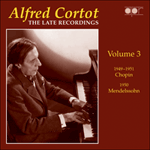 Alfred Cortot – The Late Recordings, Vol. 3 - Chopin & Mendelssohn Alfred Cortot – The Late Recordings, Vol. 3 - Chopin & Mendelssohn |
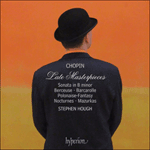 Chopin: Late Masterpieces Chopin: Late MasterpiecesStephen Hough joins the celebrations for Chopin’s 200th birthday with a disc containing much of the composer’s most extraordinary music, written in the last years of his life where the possibilities of his art were constantly unfolding as he imbue ...» More |
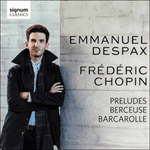 Chopin: Préludes Chopin: PréludesPianist Emmanuel Despax performs Chopin’s timeless collection of 24 Préludes alongside the Berceuse and Barcarolle.» More |
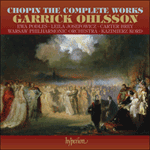 Chopin: The Complete Works Chopin: The Complete WorksSince his triumph as winner of the 1970 Chopin International Piano Competition, Garrick Ohlsson has established himself worldwide as a musician of magisterial interpretive and technical prowess. This monumental recording project—first instigated by t ...» More |
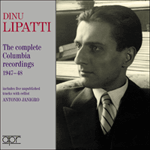 Dinu Lipatti - The complete Columbia recordings, 1947-1948 Dinu Lipatti - The complete Columbia recordings, 1947-1948 |
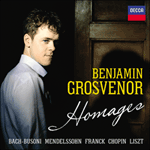 Homages HomagesBenjamin Grosvenor's imaginative exploration of works by great composers paying tribute to their predecessors: Mendelssohn and Franck look back to the Prelude & Fugue form; Busoni presents Bach’s great solo violin Chaconne in a bold and imaginativ ...» More |
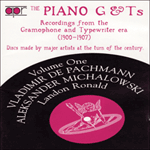 The Piano G & Ts, Vol. 1 - Vladimir de Pachmann, Aleksander Michalowski & Landon Ronald The Piano G & Ts, Vol. 1 - Vladimir de Pachmann, Aleksander Michalowski & Landon Ronald |

